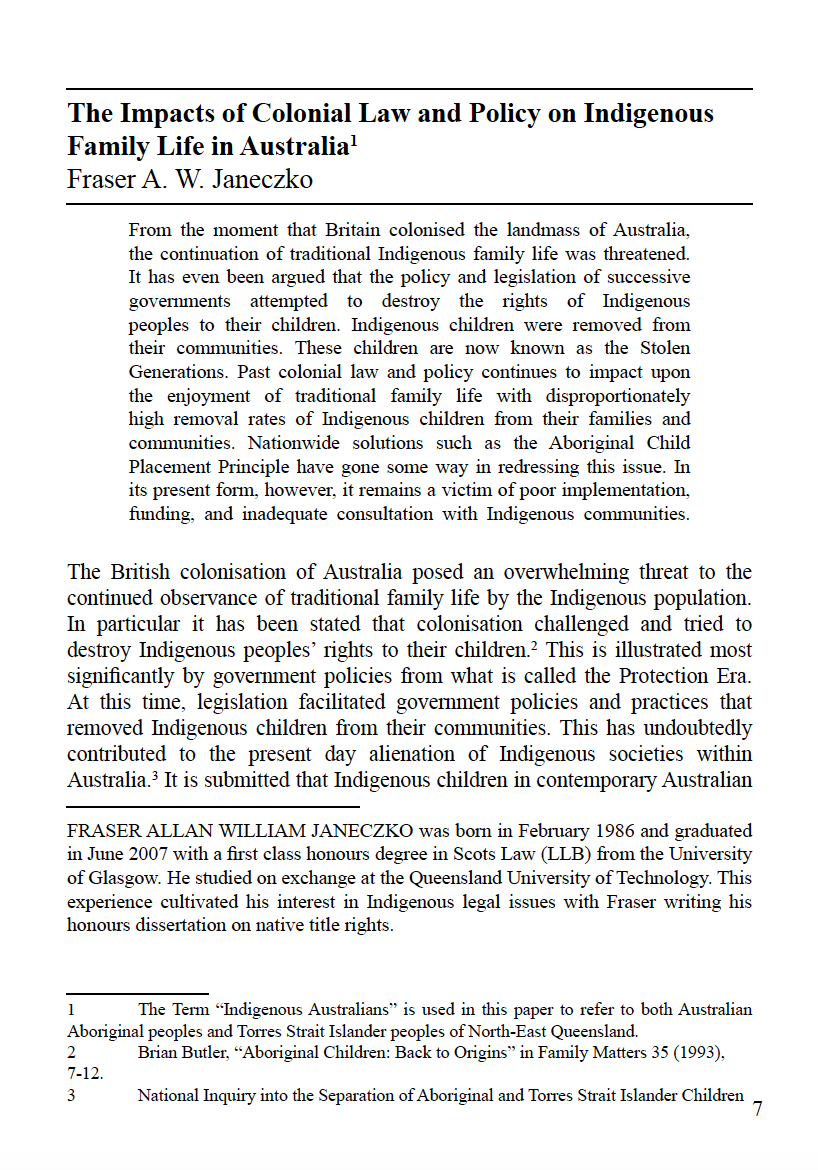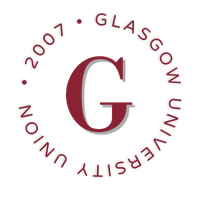The Impacts of Colonial Law and Policy on Indigenous Family Life in Australia
DOI:
https://doi.org/10.36399/GroundingsUG.1.271Keywords:
Law, Australia, Aboriginal, Torres Strait Islander, Policy, Legislation, Stolen Generations, Removals, ACPP, Indigenous, Aboriginal Child Placement PrincipleAbstract
From the moment that Britain colonised the landmass of Australia, the continuation of traditional Indigenous family life was threatened. It has even been argued that the policy and legislation of successive governments attempted to destroy the rights of Indigenous peoples to their children. Indigenous children were removed from their communities. These children are now known as the Stolen Generations. Past colonial law and policy continues to impact upon the enjoyment of traditional family life with disproportionately high removal rates of Indigenous children from their families and communities. Nationwide solutions such as the Aboriginal Child Placement Principle have gone some way in redressing this issue. In its present form, however, it remains a victim of poor implementation, funding, and inadequate consultation with Indigenous communities.
References
Aboriginal Legal Services Of Western Australia. Telling Our Story. Perth: ALSWA, 1995.
Abrahams, Melissa. “Bringing Them Home or Taking Them Nowhere: The Federal Government’s Response to the National Inquiry into the Stolen Generations.” Indigenous Law Bulletin 4(9) (1998): 15.
Attwood, Bain, Winifred Burrage, Alan Burrage and Elsie Stokie. A Life Together, A Life Apart: A History of Relations Between Europeans and Aborigines. Melbourne: Melbourne University Press, 1994.
Australian Bureau of Statistics. National Aboriginal & Torres Strait Islander Survey 1994, Detailed Findings. Canberra: AGPS, 1995.
Ban, Paul. “Aboriginal Child Placement Principle and Family Group Conferences.” Australian Social Work Volume 58, Number 4 (2005): 384-394.
Bartlett, Richard H. “The Source, Content and Proof of Native Title at Common Law”. In Resource Development and Aboriginal Land Rights in Australia. Edited by Richard H. Bartlett. Perth: Centre for Commercial Law, University of Western Australia & Murdoch University, 1993.
Butler, Brian. “Aboriginal Children: Back To Origins”. Family Matters 37(1993): 7-12.
Commonwealth of Australia, Senator the Hon John Herron, Minister for Aboriginal & Torres Strait Islander Affairs. Federal Government Submission to the Senate Legal & Constitutional References Committee Inquiry into the Stolen Generations’. Canberra: Federal Government Submission, 2000.
Cunneen, Chris. Aboriginal Justice Plan: Discussion Paper. Sydney: NSW Aboriginal Justice Advisory Council, 2002.
Cunneen, Chris. “The New Stolen Generations.” Paper presented at the Australian Institute of Criminology, Adelaide, 26-27 June 1997.
Dodson, Mick. “The Rights of Indigenous Peoples in the International Year of the Family.” Family Matters 37 (1994): 34-41.
Edwards, Coral and Peter Read. The Lost Children. Sydney: Doubleday, 1989.
Haebich, Anna. Broken Circles: Fragmenting Indigenous Families 1800-2000. Freemantle, Australia: Fremantle Arts Centre Press, 2000.
Healy, Judith, Riaz Hassan and R. B. McKenna. “Aboriginal Families.” In Ethnic Family Values in Australia. Edited by Des Storer. Sydney. Prentice Hall, 1985.
Hegarty, Ruth. Is That You Ruthie? Brisbane: University of Queensland, 1999.
Lawrie. Rowena. Speak Out Strong: Researching The Needs of Aboriginal Women in Custody. Sydney: NSW Aboriginal Justice Advisory Council, Sydney, 2002.
McRae, Heather, Garth Nettheim, Laura Beacroft and Luke McNamara. Indigenous Legal Issues: Commentary & Materials. 3rd ed. Sydney: Thomson Lawbook, 2003.
Swan, Pat. “200 years of Unfinished Business.” In Aboriginal Medical ServiceNewsletter (1988): 12-17.
Aboriginal Protection and Restriction of Sale of Opium Act (1897).
Native Title Act (1993).
United Nations Convention on the Prevention and Punishment of the Crime ofGenocide (1948).
United Nations Draft Declaration on the Rights of Indigenous Peoples (1994).
Cubillo v Commonwealth (2001) 184 ALR 249
Kruger, Bray v Commonwealth (1997) 146 ALR 126
Members of the Yorta Yorta Aboriginal Community v State of Victoria (2001) 110 FCR 244
Williams v Minister, Aboriginal Land Rights Act 1983 (1999) 25 Fam LR 86
Australian Government Department of Immigration and Multicultural and Indigenous Affairs. “Consultation on a National Plan to Address Threats to Australia’s Social Cohesion, Harmony and Security.” Available from http://www.immi.gov.au/multicultural/mcrg/Discussion_Paper.pdf. Internet;accessed 28 April 2006.
Australian Government Institute of Health and Welfare. “The Health andWelfare of Australia’s Aboriginal and Torres Strait Islander Peoples.” Available from http://www.aihw.gov.au/publications. Internet; 1 June 2007.
Australian Human Rights & Equal Opportunities Commission. “Frequently Asked Questions about the National Inquiry.” Available from http://www.humanrights.gov.au/social_justice/stolen_children/faqs.html#ques3. Internet; accessed 1 June 2007.
Law Reform Commission of New South Wales. Research Report Seven: The ACPP (1997). Available from http://www.lawlink.nsw.gov.au/Irc.nst/pages/RR7CHP3. Internet; accessed 1 June 2007.
National Inquiry into the Separation of Aboriginal and Torres Strait IslanderChildren from Their Families. Bringing Them Home (1997). Available from http://www.austlii.edu.au/au/special/rsjproject/rsjlibrary/hreoc/stolen and http://www.austlii.edu.au/au/journals/AILR/1997/36.html. Internet; accessed 1 June 2007.
Royal Commission into Aboriginal Deaths in Custody. “National ReportVolume One, (1991).” Available from http://www.austlii.edu.au/au/special/ rsiproject/sjlibrary/rciadic/national/voll/BRM_VOL1.RTF. Internet; accessed 1 June 2007.
United Nations. “United Nations Convention on the Prevention andPunishment of the Crime of Genocide (1948).” Available from http://www.law-ref.org/GENOCIDE/article2.html. Internet; accessed 1 June 2007.
United Nations. “United Nations Draft Declaration on the Rights of Indigenous Peo-ples (1994).” Available from http://www.unhch.ch/huridocda/ huridocansf/(Symbol)/E.CN.4.SUB.2.RES. 1994.45.En?OpenDocument. Internet; accessed 1 June 2007.

Downloads
Published
Issue
Section
License
Copyright (c) 2007 Fraser A. W. Janeczko

This work is licensed under a Creative Commons Attribution 4.0 International License.
The CC BY 4.0 license is a Creative Commons license. This is a non-copyleft free license that is good for art and entertainment works, and educational works. It is compatible with all versions of the GNU GPL; however, like all CC licenses, it should not be used on software. People are free to: Share — copy and redistribute the material in any medium or format; Adapt — remix, transform, and build upon the material for any purpose, even commercially. The licensor cannot revoke these freedoms as long as you follow the license terms. But they must conform to the following terms: Attribution — You must give appropriate credit, provide a link to the license, and indicate if changes were made. You may do so in any reasonable manner, but not in any way that suggests the licensor endorses you or your use. No additional restrictions — You may not apply legal terms or technological measures that legally restrict others from doing anything the license permits.
Please check individual article PDF copies to see if any additional restrictions apply.







